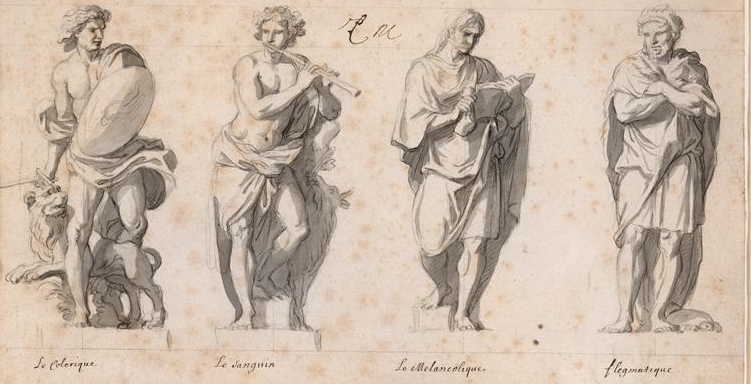Everyone Loves a Matrix: The Psychology of Player Types

What’s your guilty pleasure? Mine is taking pop-culture personality quizzes – those irresistible categorization systems that popup whenever there’s a new hit movie, game or TV show. I know these quizzes are over-simplified and silly – yet I can’t resist answering a few questions and discovering who I resemble, and how my character fits in the larger scheme of humanity.
[tweetable]We humans love a matrix that explains a world to us in simplified form.[/tweetable]
Back in ancient Greece, doctors based their treatments around the Four Temperaments: sanguine (sociable and pleasure-seeking), choleric (ambitious and leader-like), melancholic (analytical and literal), and phlegmatic (relaxed and thoughtful). The ancient Avurvedic medical practice of balancing Doshas – Vata, Pitta and Kapha – is based on similar groupings of human body/mind types.
Our medical practices have evolved greatly – yet these basic human archetypes remain alive throughout our culture. In management training we have Merrill’s Social Styles and the DISC leadership model – systems targeted at helping diverse teams work together. In literature we have the Hogwarts sorting hat – an oracle that places new students into a social group that matches their character. In pop culture, we have Rubin’s Character Index – an analysis of how different people respond to rules and expectations.
And in my field, social gaming, we have Bartle’s Player Types: Achievers, Explorers, Socializers, and Killers. Richard Bartle – an early MUD developer – noticed that certain social patterns emerged in a variety of different MUD settings – so he described these patterns as Player Types and laid out an analytic framework for thinking about online social behavior.
So far so good. Personality systems embody the wisdom of “different strokes for different folks” in a simplified, digestible form. They give us a common language for discussing and analyzing human behavior. So what’s not to like?
Things get tricky when you take a categorization system developed for one purpose and context, and transplant it elsewhere. How far can you extrapolate social patterns from one situation onto another? How can you tell if a system is giving you insight – or leading you astray? Many people (myself included) have used Bartles Player Types as a model for designing games and gamified systems. How do we discern if that’s the right model – or not?
To answer this, start by asking a few clarifying questions:
What’s the purpose of the original system? What aspect of human nature does it capture?
Any categorization system is designed for a particular purpose and context. Merrill’s Social Styles and the DISC model address how people with disparate styles can work together in teams. Rubin’s Character Index describes how individuals respond to rules and expectations. Bartle’s player types describe social patterns that arise in games that enable creating, exploring, socializing, and killing. For a deeper understanding, check out Bartle’s thoughts on how easy it is to create a matrix that captures some aspect of human experience
How does that matchup with the activities and affordances in your system?
Take a look at the structure and activities within your system If it’s people working together in teams, then the DISC or Social Styles could be a useful analytic tool. If your experience is fundamentally single-player or solo, then social models won’t work – but Rubin’s Character Index could be useful if, for example, you’re creating a habit-building product and dealing with how people personally respond to rules. Through trial and error, I learned that Bartle’s model works well for multiplayer social games — MUDs, MMOs, Arena Shooters, etc, – but less well for casual games, educational games, health games, and other genres where CORE social patterns that emerge from that particular gaming experience.
Does this system explain observed emergent behavior in your system?
The most important test for adopting any categorization system is whether it explains the social patterns you see in your own community. Those patterns are far more useful and important than any external system., If you’ve found a system that maps well, that’s a great start. Use that system as an inspiration and starting point – but don’t be afraid to tweak and change it to better matchup with your own unique situation. For example, after running into problems applying Bartle’s Player Types, I tweaked the model to better explain common behavior and motivations I was seeing. That updated model – called Kim’s Social Action Matrix – has proven to be FAR more useful for the type of lightweight social games and services I focus on.
In my next post, I’ll layout my Social Action Matrix, and show you how to make the leap from personality types to actionable affordances. Stay tuned.
If you like this post and want to read more like this, subscribe to our newsletter
February 25, 2014 @ 4:55 pm
Keep em coming, this is great stuff 🙂
February 26, 2014 @ 2:34 am
Thanks for your great insights on gamification profiles.
kosekkojak on twitter
February 26, 2014 @ 6:37 pm
A model, by definition, isn’t perfect. Utility for a given context is what matters.
That said, I’ve had good success with my “unified model” that (I think) shows some fundamental commonalities among several — but not all! — models of general personality, play styles, game design, and social organization: http://www.gamasutra.com/view/feature/134842/personality_and_play_styles_a_.php . The notion here is that there are some deep patterns of human motivation than span multiple contexts, and that getting at this foundational structure can help when trying to design for a particular context.
I’m looking forward to reading the next installment that describes the Social Action Matrix model and the context for which it’s intended. If it’s another iteration on the unified model, great; if it’s a new kind of lens with its own practical utility, also awesome. 🙂
February 28, 2014 @ 8:55 am
Great article.
Thanks.
April 9, 2014 @ 9:11 am
Hi.
Great article.
Thanks.